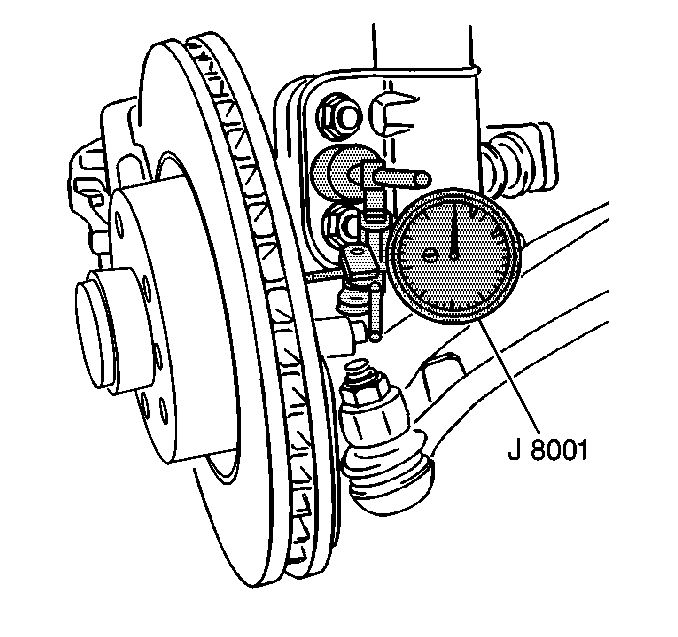A vehicle that exhibits brake pulsation or a shudder condition during braking may be caused by a brake rotor with excessive lateral runout.
Tools Required
J 8001 Dial Indicator Set
- Raise and support the vehicle. Refer to Lifting and Jacking the Vehicle in General Information.
- Refer to Wheel Bearings Diagnosis in Suspension General Diagnosis.
- Remove the tire and wheel. Refer to Wheel Removal in Tires and Wheels.
- Install and fully seat the wheel nuts in order to securely retain the rotor.
- Fasten the J 8001 to the knuckle. Ensure that the indicator button contacts the rotor surface about 13 mm (0.500 in) from the outer edge.
- Set the dial indicator to zero.
- Turn the wheel one complete revolution. Inspect the runout indicated on the dial.
- Mark the relationship of the rotor to the hub.
- Remove the brake rotor. Refer to Brake Rotor Replacement .
- Clean any rust or foreign material from the mating surface of the rotor and the hub.
- Install the brake rotor to the hub, one or two bolt positions from the rotor's original position. Repeat Steps 5 through 8.
- Remove the wheel nuts from the bearing/hub.
- Install the tire and wheel. Refer to Wheel Installation in Tires and Wheels.
- Lower the vehicle.
Important: Before performing the brake rotor lateral runout check, inspect the wheel bearing/hub for excessive looseness and excessive lateral runout.

| • | If the runout exceeds 0.080 mm (0.003 in), go to Step 8. |
| • | If the reading is less than 0.080 mm (0.003 in), go to Step 13. |
Notice: Whenever the brake rotor has been separated from the wheel bearing flange, clean any rust or foreign material from the mating surface of the rotor and flange with the J 42450 hub cleaning kit. Failure to do this may result in increased lateral runout of the rotor and brake pulsation.
If the runout still exceeds 0.080 mm (0.003 in), refinish or replace the rotor as necessary.
For the front rotor refinishing procedure, refer to Brake Rotor Refinishing .
